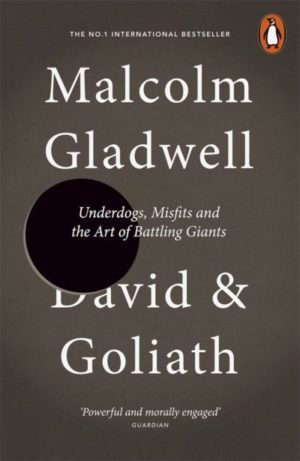Malcolm Gladwell’s ‘David and Goliath’ is about how people face giants, whether they’re powerful opponents or forces outside our control. Opening with the legend of David and Goliath, Gladwell uses several real-life stories to illustrate his points. The stories chosen, with Gladwell’s commentary, draw out the key points in an easy to understand manner. However, Gladwell avoids presenting counter points that illustrate where the ideas he presents fail. While this shouldn’t detract from the validity of the points presented, it is important to take those same points with a grain of salt; they may not apply to every circumstance. ‘David and Goliath’ highlighted some useful and practically applicable concepts. As I was reading through it, I was often side-tracked with how these ideas fit into the real world and could be used.
The first section of the book is ‘The Advantages of Disadvantages (and the Disadvantages of Advantages)’. The key points are the power of the underdog to change the rules of the game (the underdog’s restricted resources and freedom of action can lead to strategies that avoid the greater power’s strengths), the prevalence of the inverted-U chart (a graphical representation in favor of moderation to mitigate the problem of too much of a good thing), and the role of comparison and relative deprivation in how we perceive ourselves and the world (perception is frequently based on comparison to available information around us). This section can help us to explore strategic problems by understanding the game the opposition is playing, the game we are playing, and whether these two games are the same and if they should be the same. The inverted-U applies to many areas of life, such as diet and exercise, work-life balance, resource allocation, and many more. Additionally, it can help us to perceive how others may view their own situations in comparison to our own and vice versa. This, ideally, leads to better thinking, and better strategies.
The second section is ‘The Theory of Desirable Difficulty’. It focuses on how adversity can lead to improvement and growth. One example is capitalisation versus compensation learning, which is building on existing strengths versus developing alternative skills to compensate for a deficiency. An associated element of desirable difficulty is that it can force us to slow down the process, leading for more deliberate practice and better learning. Another concept from this section is that of near and remote misses. This explores the impact of proximity to disaster and tragedy on performance. This concept highlights the relationship between our fear of an event and our actual response to that event, and the impact of the contrast in this relationship.
The final point of this chapter is the freedom to break the rules that is provided by being in a position with nothing left to lose. Linked into this, is the importance of deception and perception control in the success of any campaign, but that it can often result from necessity rather than strength. The second section can be applied to learning, training and education, by using desirable difficulty to optimise learning and through utilising the concept of remote misses to inculcate resilience through controlled exposure. This section can also be applied beyond learning, such as applying the idea of compensation versus capitalisation learning procurement strategies; are the capabilities we’re procuring building on a strength or are they compensating for a weakness in another area.
The third section explores the limits of power and authority, specifically the role of legitimacy in exercising authority. Gladwell argues there are three elements to legitimate power: providing a voice to the subjects of authority, being predictable, and being fair. This point also relates to the second chapter of this section which highlights the limits of disciplinary actions; make punishments too extreme and people may stop caring about the punishment. The second chapter of this section also examines how people react to events and the choices that are faced. The final chapter points out how previous adversities can lead to unexpected strengths. I personally found this section the weakest of the three when I initially read it. However, it still has applications for understanding the relationship between authority, legitimacy, and adversity, particularly in light of the current crisis. Many of the concepts from this chapter can be applied to how authorities respond to crises, enforce their decisions, and how the choices made today may lead to unexpected results.
Overall, Malcolm Gladwell’s ‘David and Goliath’ was an enjoyable read that had some practical concepts in it. While he doesn’t comment on the limits and misapplications of these concepts, they are nonetheless valuable mental models that deserve thought. The book is probably more useful to those beginning their journey but may still have value to the more experienced by clearly stating some of the concepts they may have come across.

